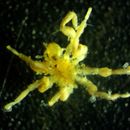Look Alikes
provided by Invertebrates of the Salish Sea
How to Distinguish from Similar Species: A variety of local intertidal pycnogonids, such as Pycnogonum stearnsi, have thick, short legs not much longer than the proboscis + trunk. Several other Achelia species have fingerlike coxal projections; and Achelia chelata has chelae as adults. Ammothea verenae lives at hydrothermal vents.
- license
- cc-by-nc-sa
- copyright
- Rosario Beach Marine Laboratory
Habitat
provided by Invertebrates of the Salish Sea
The genus Achelia is found in cold temperate and subpolar regions of the north and south Pacific ocean, including Antarctica. This individual was on an Epiactis prolifera anemone on the open coast.
- license
- cc-by-nc-sa
- copyright
- Rosario Beach Marine Laboratory
Distribution
provided by Invertebrates of the Salish Sea
Geographical Range: From Korea across the North Pacific and Aleutian Islands to central and perhaps southern California.
- license
- cc-by-nc-sa
- copyright
- Rosario Beach Marine Laboratory
Comprehensive Description
provided by Invertebrates of the Salish Sea
Order Pantopoda is the only Order in Class Pycnogonida. Family Ammotheidae is one of the largest and most variable families of pycnogonids. Members of Family Ammotheidae usually have chelifores, but some species have no chelifores or have no chelae on them. The palps have 1 to 10 articles. Both males and females in this family have 9 to 10-segmented ovigers, which are larger in males. This pycnogonid species has legs much longer than the body. It has both chelicerae and pedipalps, but the chelicerae have just two articles and the second article is simply a knob which does not extend past the end of the proboscis. The pedipalps have 8 articles. There are no short, fingerlike projections on the dorsodistal edges of the coxa of the first legs.
- license
- cc-by-nc-sa
- copyright
- Rosario Beach Marine Laboratory
Comprehensive Description
provided by Smithsonian Contributions to Zoology
Achelia latifrons (Cole)
Ammothea latifrons Cole, 1904:263-266, pl. XI: fig. 3; pl. XVI: figs. 1–9; pl. XVII: figs. 1–3.—Schmitt, 1934:68.—Hedgpeth, 1941:256 [key].—Hilton, 1942b:295–296, pl. 41; 1942g:93.
Achelia latifrons.—Stock, 1954:96–97.—Kim and Hong, 1986:46–48, fig. 8.
MATERIAL EXAMINED.—Aleutians, Kiska Island, Kiska Harbor, coll. W.H. Dall, 1872 (1); same locality, coll. W.H. Dall, 1873 (2, 1 juv); same locality, coll. W.H. Dall, 7 Jul 1873 (1, 2); same locality, coll. W.H. Dall, sta 164 (1001), 1873 (1 with eggs); same locality, coll. W.H. Dall, sta 167 (1000), 16–22 ms, 1873 (1); same locality, coll. W.H. Dall, sta 211 (1025), intertidal, 1873 (2 with eggs, 1, 1); Kiska Island, Biological Survey, coll. W.L. Schmitt, 1940? (5).
Aleutians, Amchitka Island, Constantine Harbor, coll. W.H. Dall, sta (1049), at shore, 5 Aug 1873 (1 with eggs, 1, 1).
Aleutians, Adak Island, coll. W.H. Dall, sta 315 (1015), 1873 (1); same locality, S side of Clam Lagoon, 51°55′N, 176°34′W, coll. J. Rosewater, sta JR-10-79, intertidal, on sabellid worm tubes, 8 Jun 1979 (1, 1 juv).
Aleutians, S of Tanaga Island, 51°52.3′N, 177°44.5′W, 119 m, R/V Miller Freeman, cruise 833, sta 42, 4 Aug 83 (1, 1 juv.).
DISTRIBUTION.—Another species with a very wide distribution across the North Pacific, from the Korean coast through the western Aleutian Islands, Pribilof Islands, Alaskan coast, to middle California and possibly to southern California. The specimens from cruise 833, station 42 above probably represent the deepest record for this normally shallow-water species. Hilton published a record from Santa Barbara, California, but I have not seen the specimen. His identifications have averaged about 50% correct, of specimens I have examined.
DIAGNOSIS.—Extremely setose/spinose species. Trunk circular in dorsal view, with 4–5 short median spines or sometimes spines lacking. Lateral processes contiguous, with many laterodistal setae continuing laterally on all first coxae, also with slender paired dorsodistal tubercles with spines at their tips. Ocular tubercle moderately long, eyes prominent. Proboscis slightly inflated, ovoid. Abdomen very long, with long paired dorsal spines.
Palp segments short, second slightly longer than fourth, all with few dorsal setae and few ventral setae on distal 5 segments. Chelifores with many setae on scapes, most longer than segment diameter, and several short dorsal tubercles each with spine. Chela fingers atrophied, with single spine. Oviger with 3–4 rows of short spines on major segments, 4 strigilis segments with paired denticulate spines.
Leg tibiae with many long dorsal setae, some originating on low tubercles, femur with few similar lateral and ventral setae. Second coxae of posterior 2 pairs of legs with genital spur slightly longer than segment diameter. Fernur with dorsodistal tubercle as long as segment diameter, tubercle bearing tiny cement gland tube laterally near tip. Propodus slender, well curved, with 3 major heel spines, 8–10 very small sole spines, and several lateral and dorsal setae. Claw long, little curved, auxiliaries slender, about 0.6 the main claw length.
- bibliographic citation
- Child, C. Allan. 1995. "Pycnogonida of the Western Pacific Islands, XI: Collections from the Aleutians and other Bering Sea Islands, Alaska." Smithsonian Contributions to Zoology. 1-29. https://doi.org/10.5479/si.00810282.569

